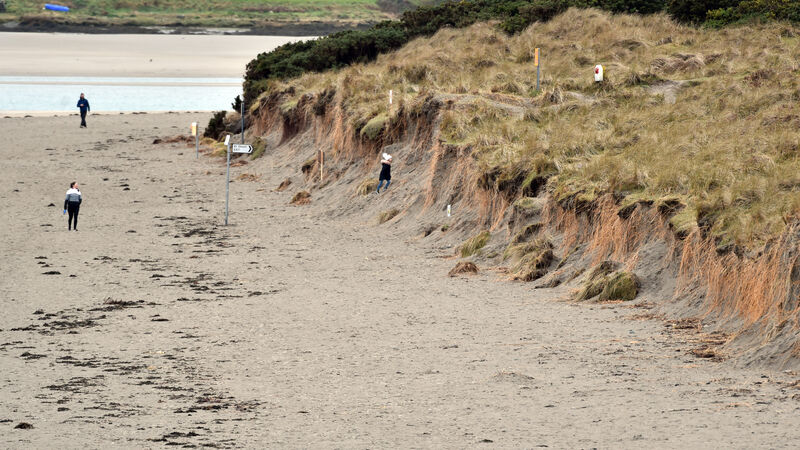Damien Enright: Our sand dunes are threatened with disappearance

Sand dunes at Inchydoney beach in West Cork eroded by winter storms. We have a part to play in protecting them. Picture: Eddie O'Hare
When we were children on beach holidays, we ran our heedless ways through the knee-high marram grass of the sand dunes at Inchydoney Strand in West Cork. We little knew that we might have been wrecking the root systems of the grass that held them together. Still, year on year, they survived. We were few, and we were lightweight. It was before the age of universal motor cars and free-range mobility.
Since then, holidaymakers have multiplied by a factor of thousands, and the passage of adults, children and dogs, teenage campers, and midnight dune parties are wreaking havoc on these delicate ecosystems which we will sorely miss when they are gone. In Ireland, we don't have dunes except by the sea. They're another world for the landlocked soul.
Emily Dickinson, the passionate New England spinster poet once wrote 'Exultation is the going/ Of an inland soul to sea...' Exultation, indeed! Well did she understand it, and powerfully did she put it, the 'divine latent intoxication' of yellow sand dunes backing a white beach, fronting a blue sea.
The dunes at Inchydoney — like those at Garafeen, Courtmacsherry Bay, at Youghal in East Cork, at Castlegregory in Kerry, and at many other popular beach resorts — are threatened with imminent disappearance and the land behind them with inundation by the sea. They have been there 'forever'. But, over the last 30 years, they have begun to collapse, with the sand 'cliffs' that provided barriers being washed away.
We know the reasons. First amongst them is human activity, wrecking the webs of marram roots beneath the sands. As sentient beings, we can stop this. We can stop invading them ourselves, and we can stop the sea invading them. Unless we take action, we will lose not only the sand cliffs but the land behind them. The sea, given free rein, will take this unto itself, too.
At Inchydoney, Cork County Council, installed a road leading to a car park with a pathway to reach the beach via a gap made in the dunes. Entrance and Exit signs were erected. The sea, in storm, didn't need the signs. Wave after wave, it availed of the gap, rushed in and spread, unfettered, behind the dunes. Marram's thick, waxy leaves can withstand heat and drought but its roots can't survive in salt water. Dena O'Donovan's photos, alongside a comprehensive, informative, and passionate article in by Deirdre Hurley, a marine biologist, and ecologist, and another by Jackie Keogh, illustrated the resultant damage.

Dunes are, we know, barriers created by nature to protect the precious soil of the land behind them, and all that live on it. Marram holds them together; the more it grows, the more sand is trapped, and the more the dune grows. Inchydoney Dunes Conservation Project, (inchydoneydunesconservation@gmail.com) an action group recently formed, is seriously on the case. Planting marram is an important step, and volunteers have pledged to help.
Wind blows sand into an area of relative shelter. Flora and fauna arrive, unique, fragile, and precious. Shelter can be created by obstacles, as crude and heavy as gabions — wire-mesh boxes filled with rocks — or by more aesthetic and environmentally-friendly wooden-post fencing. But money is needed for either. Cork County Council has spent millions on flood protection measures on the Bandon and Clonakilty rivers which many locals believe will damage the river fauna irrevocably, notably the spectacular salmon runs in Bandon.
In 2013, I wrote about the dereliction of Inchydoney dunes, and the dereliction of duty by our government vis-a-vis its shameful conservation record. Cack-handedness is part of the problem, engineers are consulted before environmentalists. The debacle of the aforementioned beach-access path is an example. Unbelievably, there's just one ecologist-qualified conservation officer serving all of counties Cork and Kerry. Successive governments have budgeted a miserly €13 million for conservation measures over the whole of Ireland. The budget, recently increased to €29m, is a 'spit in the ocean', even in terms of marine conservation alone.
Dunes are a public amenity. Until Inchydoney and other systems in danger are 'repaired', the first action should be to keep the public off them except, perhaps, on boardwalks within the dunes, definitely without passageways leading onto the beach. Perhaps, we might all, this coming summer, adopt TS Eliot's Prufrock resolution 'I shall wear white flannel trousers and walk upon the beach', trousers optional, of course.
Dunes, with their undulations of form and ululation of wind on wild days, are perenially poetic. The plain poet, Robert Frost, wrote, 'Sea waves are green and wet,/ But up from where they die,/ Rise others vaster yet,/ And those are brown and dry.'
Let us keep them 'brown and dry' and not wash away.










